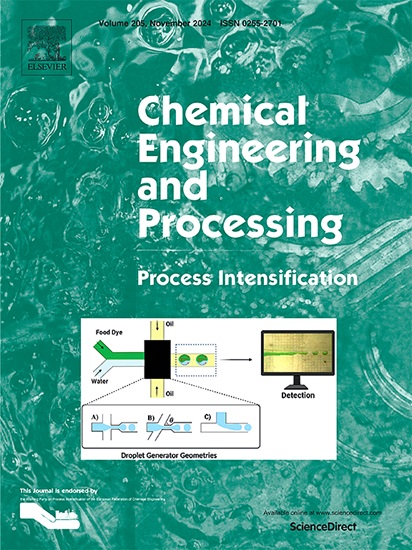Effects of CaO/MgO compositions on the performances of sorption enhanced water gas shift reaction: A thermodynamic analysis
IF 3.8
3区 工程技术
Q3 ENERGY & FUELS
Chemical Engineering and Processing - Process Intensification
Pub Date : 2025-03-24
DOI:10.1016/j.cep.2025.110287
引用次数: 0
Abstract
The CO2 sorption-enhanced water gas shift reaction (SE-WGSR) is a promising approach that facilitates in-situ CO2 capture and promotes hydrogen yields by shifting the equilibrium of the WGSR towards higher CO conversion. Developing an effective sorbent/catalyst is one of the key challenges for industrial-scale applications of SE-WGSR technology. The present study investigated mixed CaO/MgO as a sorbent material for an SE-WGSR process. The performances of the SE-WGSR with various concentrations of CaO/MgO mixtures were analyzed by using the Gibbs free energy minimization method. The ultimate objective was to secure a high CO conversion and a low energy requirement for sorbent regeneration. The results showed that the increasing CaO in the CaO/MgO mixture significantly increased the CO conversion, while the increase in MgO decreased the total sorbent regeneration enthalpy. A CaO/MgO mixture of 20 mol % CaO was identified as the optimal sorbent composition, achieving a 29.3 % higher CO conversion in comparison to 100 % MgO sorbent at 40 bar pressure and 350 °C, requiring 14.1 % less regeneration enthalpy than a 100 mol % CaO sorbent. Therefore, the optimal sorbent mixture composition can result in the realization of an efficient SE-WGS process to achieve high CO conversion at the appropriate regeneration energy cost.

CaO/MgO组分对吸附强化水煤气转移反应性能的影响:热力学分析
二氧化碳吸附增强水气转换反应(SE-WGSR)是一种很有前途的方法,通过将WGSR的平衡转向更高的CO转化率,促进原位CO2捕获和氢产量。开发有效的吸附剂/催化剂是SE-WGSR技术实现工业规模应用的关键挑战之一。本研究研究了混合CaO/MgO作为SE-WGSR工艺的吸附材料。采用吉布斯自由能最小化法分析了不同浓度CaO/MgO混合物对SE-WGSR性能的影响。最终目标是确保高CO转化率和吸附剂再生的低能量要求。结果表明,CaO/MgO混合物中CaO含量的增加显著提高了CO转化率,而MgO含量的增加降低了吸附剂的总再生焓。在350°C和40 bar压力下,与100% MgO吸附剂相比,20 mol % CaO/MgO混合物的CO转化率提高了29.3%,所需的再生焓比100 mol % CaO吸附剂低14.1%。因此,最佳的吸附剂混合物组成可以实现高效的SE-WGS工艺,以适当的再生能源成本实现高CO转化率。
本文章由计算机程序翻译,如有差异,请以英文原文为准。
求助全文
约1分钟内获得全文
求助全文
来源期刊
CiteScore
7.80
自引率
9.30%
发文量
408
审稿时长
49 days
期刊介绍:
Chemical Engineering and Processing: Process Intensification is intended for practicing researchers in industry and academia, working in the field of Process Engineering and related to the subject of Process Intensification.Articles published in the Journal demonstrate how novel discoveries, developments and theories in the field of Process Engineering and in particular Process Intensification may be used for analysis and design of innovative equipment and processing methods with substantially improved sustainability, efficiency and environmental performance.

 求助内容:
求助内容: 应助结果提醒方式:
应助结果提醒方式:


